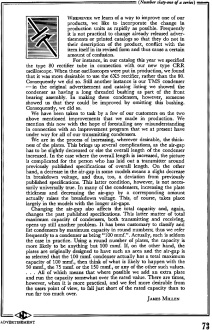March 1939 QST
 Table
of Contents Table
of Contents
Wax nostalgic about and learn from the history of early electronics. See articles
from
QST, published December 1915 - present (visit ARRL
for info). All copyrights hereby acknowledged.
|
National Company, an early manufacturer of
electronics components for radio products, ran a series of unique advertisements
in the ARRL's QST magazine.
Rather than using precious cash for directly promoting specific products or product
lines, company president John Millen occupied full pages with text explaining why
it makes the things it does and how they can be used to solve problems or enhance
performance. This article/ad on TMS condensers (aka variable capacitors) was number
61 in the series, which means if they printed one every preceding month, the first
would have appeared in the March 1934 issue of QST.
National Company Advertisement
 (Number sixty-one of a series) (Number sixty-one of a series)
Whenever we learn of a way to improve one
of our products, we like to incorporate the change in production units as rapidly
as possible. Frequently it is not practical to change already released advertisements
or printed catalogs so that they do not in their description of the product, conflict
with the item itself in its revised form and thus cause a certain amount of confusion.
For instance, in our catalog this year we specified the type 80 rectifier tube
in connection with our new type CRR oscilloscope. When these oscilloscopes were
put in production, we found that it was more desirable to use the 6X5 rectifier,
rather than the 80. Consequently we did so. Still another instance is our TMS condenser
- in the original advertisement and catalog listing we showed the condenser as having
a long threaded bushing as part of the front bearing assembly. In making these condensers,
however, someone showed us that they could be improved by omitting this bushing.
Consequently, we did so.
We have been taken to task by a few of our customers on the two above mentioned
improvements that we made in production. We mention this now with the hope of forestalling
any misunderstanding in connection with an improvement program that we at present
have under way for all of our transmitting condensers.
We are in the process of increasing, wherever desirable, the thickness of the
plates. This brings up several complications, as the air-gap has to be slightly
decreased or else the overall length of the condenser increased. In the case where
the overall length is increased, the picture is complicated for the person who has
laid out a transmitter around previously published specifications of overall length.
On the other hand, a decrease in the air-gap in some models means a slight decrease
in breakdown voltage, and thus, too, a deviation from previously published specifications.
This latter condition, however, is not necessarily universally true. In many of
the condensers, increasing the plate thickness and decreasing the air-gap by a corresponding
amount actually raises the breakdown voltage. This, of course, takes place largely
in the models with the longer air-gaps.
Changing the air-gap also affects the total capacity and, again, changes the
past published specifications. This latter matter of total maximum capacity of condensers,
both transmitting and receiving; opens up still another problem. It has been customary
to classify and list condensers by maximum capacity in round numbers; thus we refer
frequently to a condenser as being "100 mmf.". Actually, such is seldom the case
in practice. Using a round number of plates, the capacity is more likely to be anything
but 100 mmf. If, on the other hand, the plates are originally designed to have such
an area and the air-gap is so selected that the 100 mmf. condenser actually has
a total maximum capacity of 100 mmf., then think of what is likely to happen with
the 50 mmf., the 75 mmf. or the 150 mmf., or any of the other such values ... All
of which means that where possible we add an extra plate and run the capacity somewhat
over the rated value. There are times, however, when it is more practical, and we
feel more desirable from the users point of view, to fall just short of the rated
capacity than to run far too much over.
Posted March 24, 2023
(updated from original post
on 1/12/2017)
Here are all the National Company advertisements I have:
- National's Company:
Merry Christmas and Happy New Year, January 1941
- National Company:
Noise Limiters, September 1950
- National Company: Modulators, April
1942
- National Company: Switches,
May 1939
- National Company: TMS Condenser, March 1939
- National Company: TVI, October
1953
- National Company:
Amateur Radio Activity, December 1952
- National Company: HRO-50
Receiver, May 1951
- National Company:
Noise Limiters, September 1950
- National
Company: Modulation, October 1947
- National Company:
Merry Christmas and Happy New Year, January 1942
- National Company:
Merry Christmas and Happy New Year, January 1941
- National Company: Switches,
May 1939
- National Company: AC Power Strip,
April 1939
- National Company: TMS Condenser,
March 1939
- National Company Catalog: NC80X
/ NC81X Receiver Advertisement, September 1937
- National Company:
IF Circuits, September 1935
|










